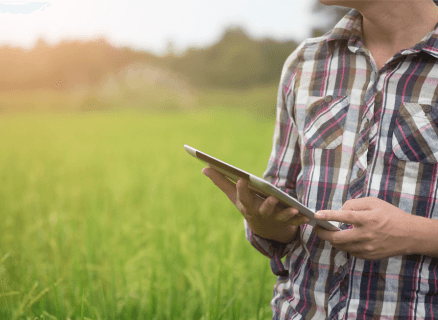Data analytics
Big data
AI tools
Software development
Security practices
Marketing strategies
More Crop for Less Cash: The Data-Driven Agriculture Revolution
Nadiia Sidenko
2024-10-10
The global agricultural landscape is undergoing a monumental shift, thanks to the rise of data-driven agriculture (DDA). This cutting-edge approach combines the power of artificial intelligence (AI), the Internet of Things (IoT), and big data to transform how farmers manage their land and resources. With the demand for food increasing alongside growing environmental concerns, the agricultural sector is embracing DDA to improve yields, reduce costs, and promote sustainability.

Data-Driven Agriculture: A Game Changer for Modern Farming
Data-driven agriculture refers to the use of advanced technologies that allow farmers to make informed decisions based on real-time data collection and analysis. By leveraging sensors, drones, AI algorithms, and satellite imagery, farmers gain unprecedented insights into their operations. These technologies enable more precise use of water, fertilizers, and pesticides, while minimizing waste and environmental impact.
For instance, soil moisture sensors can alert farmers to the exact irrigation needs of their crops, preventing both overwatering and underwatering. Similarly, AI-powered tools can analyze data from plant health sensors to detect diseases at early stages, ensuring timely treatment and preventing large-scale crop losses.
Precision Agriculture: A New Era of Resource Efficiency
Traditional farming methods often relied on generalized knowledge, intuition, and experience. However, DDA offers a more tailored approach, known as precision agriculture. Precision agriculture harnesses a variety of data sources—from weather patterns to soil composition—and combines them to guide farming decisions with surgical precision.
Farmers can now adjust their practices based on the unique characteristics of different sections of their fields. For example:
- Targeted Fertilization: By analyzing soil nutrient levels, DDA can recommend precise amounts of fertilizer for different areas, reducing waste and improving crop health.
- Optimized Water Usage: With real-time data on soil moisture, farmers can create irrigation schedules that are tailored to the specific water needs of each section of their field, conserving water and preventing damage to crops.
- Pest Control Efficiency: DDA can also help in monitoring pest activity. Data from sensors and drones allows farmers to pinpoint infestations and target treatments, reducing the use of pesticides and improving environmental sustainability.
Key Benefits of Data-Driven Agriculture
The impact of DDA goes beyond yield improvement—it revolutionizes the economics and sustainability of farming. Here are some major benefits:
- Cost Reduction: Data-driven insights allow farmers to optimize the use of inputs such as water, fertilizer, and pesticides, reducing operational costs.
- Early Detection of Plant Stress: AI-powered systems can detect subtle changes in plant health, such as nutrient deficiencies or early signs of disease, allowing for timely intervention before significant crop losses occur.
- Increased Efficiency: Automated systems powered by data analysis make tasks like irrigation, fertilization, and pest control more efficient, saving time and resources.
- Sustainability: By minimizing resource wastage and reducing environmental harm, DDA promotes sustainable agricultural practices, safeguarding the ecosystem for future generations.

The Future of Farming
The Future of Farming: Autonomous Farms and Advanced Technologies
Looking ahead, DDA will continue to evolve and reshape farming practices globally. Several key trends are likely to define the future of agriculture:
- Autonomous Farms: Robotic systems will play a larger role in farming, from planting seeds to harvesting crops. This level of automation reduces labor costs and enhances precision.
- Predictive Analytics: AI models will become increasingly sophisticated, allowing farmers to predict crop yields with greater accuracy and adjust their strategies to maximize returns.
- Blockchain Integration: Blockchain technology can provide full transparency within the agricultural supply chain. Consumers will be able to trace food products from the farm to their table, building trust and ensuring product authenticity.
- Drones and Satellite Monitoring: Advances in drone technology and satellite imaging will offer farmers real-time views of their fields, enabling them to monitor crop health and growth with unparalleled detail.
Empowering Farmers to Thrive in a Data-Driven World
The adoption of data-driven agriculture marks the beginning of a new era in farming—one where technology and data enable farmers to grow more with fewer resources. This transformation not only improves profitability but also addresses the environmental challenges associated with modern agriculture. By embracing DDA, farmers can cultivate a future where agricultural abundance is achieved without compromising sustainability.
Data-driven agriculture is more than just a trend—it's a necessity for meeting the growing global demand for food while reducing the environmental footprint of farming. As we move into 2025 and beyond, the continued integration of AI, IoT, and data analytics in agriculture will create a smarter, more efficient, and more sustainable farming industry. This revolution is poised to provide a secure food supply for future generations, ensuring that farmers can produce more crops for less cash.